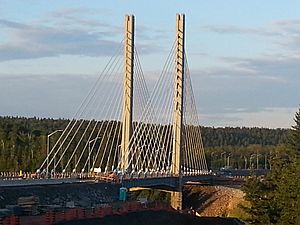Nipigon River Bridge facts for kids
Quick facts for kids Nipigon River Bridge (2015) |
|
|---|---|
 |
|
| Coordinates | 49°01′11″N 88°15′01″W / 49.0196°N 88.2504°W |
| Carries | 4 lanes of Trans-Canada Highway (Highway 11 / Highway 17) |
| Crosses | Nipigon River |
| Locale | Nipigon, Ontario |
| Maintained by | Ministry of Transportation of Ontario |
| Characteristics | |
| Design | Cable-stayed |
| Total length | 252 metres (827 ft) |
| Width | 37 metres (121 ft) |
| Height | 75 metres (246 ft) |
| Number of spans | 2 |
| History | |
| Designer | McCormick Rankin (MRC) |
| Constructed by | Bot Construction and Ferrovial Agroman |
| Construction begin | 2013 |
| Construction end | 2018 (estimated) |
| Construction cost | $106 million |
| Opened | November 29, 2015 (westbound bridge) |
| Replaces | Nipigon River Bridge (1937, 1974) |
| Lua error in Module:Location_map at line 420: attempt to index field 'wikibase' (a nil value). | |
The Nipigon River Bridge is a special kind of bridge in Canada. It carries two major highways, Highway 11 and Highway 17, which are part of the Trans-Canada Highway. This bridge crosses the Nipigon River near a town called Nipigon, in Ontario.
Contents
Bridge History
The area where the Nipigon River Bridge stands has seen a few bridges over the years.
Early Bridges
In 1937, a steel bridge was built here for cars and trucks. It was next to an existing railway bridge.
Later, in 1974, that first bridge was replaced. The new bridge was made of steel plates. In the mid-2000s, this 1974 bridge was updated. It got new steel guardrails that offered a better view of the river. A walkway for people was also added on the north side.
Dismantling the Old Bridge
The 1974 bridge was taken down between 2015 and 2016. This was done to make room for the second part of the new bridge. Taking apart the old bridge was a difficult job. It was done over icy water during a cold winter in northern Ontario. The project even won awards for how well it was handled.
The New Bridge
Building a new bridge started in 2013. This was part of a bigger plan to make the Trans-Canada Highway wider, with four lanes. The new Nipigon River Bridge cost $106 million.
Unique Design
The new bridge uses a special design called "cable-stayed." This means the bridge deck is held up by strong cables that connect to tall towers. This was the first time this type of bridge was built in Ontario. The plan was for two parallel bridges, each carrying two lanes of traffic.
Opening the New Spans
The first part of the new bridge, for westbound traffic, opened on November 29, 2015. All traffic then used this new bridge while the old one was taken down. The second part of the bridge, for eastbound traffic, was finished in 2018. By the end of November 2018, the entire bridge was open, with two lanes of traffic in each direction.
Bridge Closure and Repairs
On January 10, 2016, something unexpected happened. The new bridge had to close completely.
What Happened?
The bridge is designed to be a bit unbalanced, with one side longer than the other. To keep it stable, the shorter, western side needs to be held down. This is done by special parts called "bearings." These bearings hold the bridge deck down but also allow it to move a little bit when the temperature changes.
During a winter storm, 40 bolts that held one of these bearings failed. This caused the bridge deck to lift up by about 60 centimeters (24 inches). Because of this, the Trans-Canada Highway was closed at the bridge.
Impact of the Closure
This bridge is very important because it's the only way to cross the river for a long distance. Its closure meant that vehicles traveling between eastern and western Canada had to take a long detour through the United States. This caused big problems for travel and shipping. One nearby town even declared a state of emergency.
Temporary Fixes
The very next morning, after 17 hours, the bridge was partly reopened. Only one lane was used, with traffic taking turns going in each direction. The Ministry of Transportation checked the bridge carefully. They decided it was safe for cars and regular trucks. Heavy concrete barriers were placed on the bridge to help weigh down the deck.
A temporary support system was put in place to hold the bridge down. By February 25, 2016, the bridge was fully open again, with one lane in each direction. The exact reason for the failure was still being investigated at this time.
Why Did It Fail?
In September 2016, reports explained why the bridge failed. Experts found three main reasons:
- Flexible Plate: A metal plate connecting the bearing to the bridge was too flexible. This caused extra stress on some of the bolts.
- Bearing Issues: The bearings could not turn properly. This meant they couldn't adjust to how the bridge deck met the concrete support. This put more weight on one end of the bearing.
- Loose Bolts: The bolts were not tightened enough. This made them weaker over time and more likely to break.
Permanent Repair
The permanent repair for the bridge involved a new "linkage" system. This system holds the bridge down securely. It also allows the bridge to expand and shrink safely with temperature changes.


